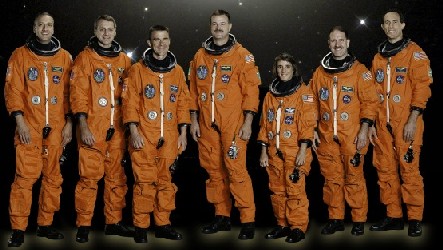March 01 - 12, 2002
Columbia
The Crew

(November 2001) --- Seven astronauts take a break from training for the STS-109 mission to pose for the traditional pre-flight crew portrait. From the left are astronauts Michael J. Massimino, Richard M. Linnehan, Duane G. Carey, Scott D. Altman, Nancy J. Currie, John M. Grunsfeld and James H. Newman. Altman and Carey are commander and pilot, respectively, with the others serving as mission specialists. Grunsfeld is payload commander. The group will be the fourth to visit the Hubble Space Telecope (HST) for performing upgrade and servicing on the giant orbital observatory.
The Artwork
AUGUST 2001--STS-109 is the fourth mission to service the Hubble Space Telescope (HST). The mission patch depicts the Hubble Space Telescope and the Space Shuttle Columbia over the North American continent. During the eleven-day mission, the crew of Columbia will rendezvous with the telescope and grapple and berth it to the Space Shuttle using the remote manipulator system. Then, a series of space walks will be performed to significantly upgrade HST's scientific capabilities and power system. Inside of HST's aperture is a portrayal of the spectacular Hubble Deep Field Image, representing the billions of stars and galaxies in the Universe. This Deep Field Image symbolizes all the major discoveries made possible by the Hubble Space Telescope over the last ten years, and all those to come following the installation of the Advanced Camera for Surveys (ACS) by the crew of STS-109. The ACS is the major scientific upgrade for this servicing mission and will dramatically increase HST's ability to see deeper into our universe. To further extend HST's discovery potential, a new cooling system will be added that will restore HST's infrared capability. The telescope is also shown with the smaller, sturdier, and more efficient solar arrays that will be installed during the space walks on STS-109. When combined with a new Power Control Unit, these solar arrays will provide more power for use by the telescope and allow multiple scientific instruments to operate concurrently.